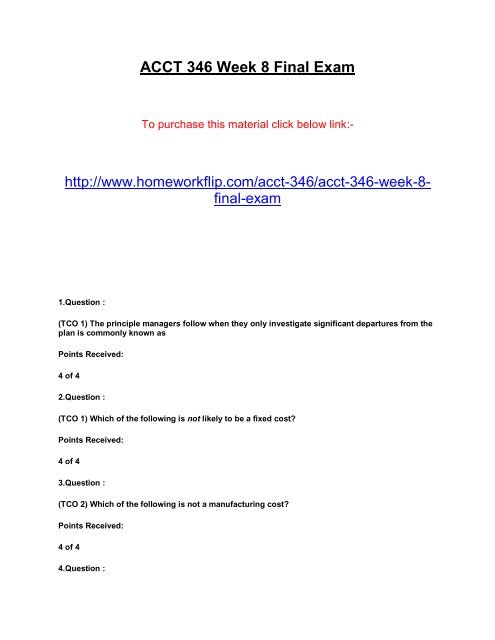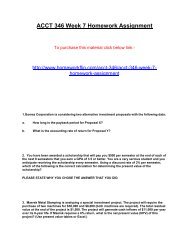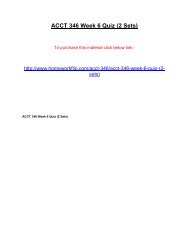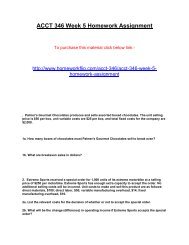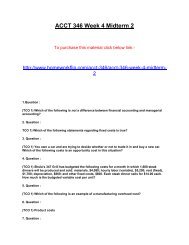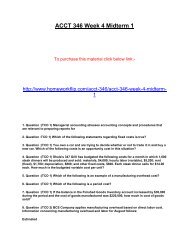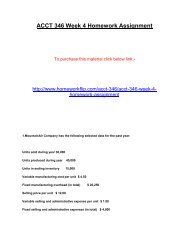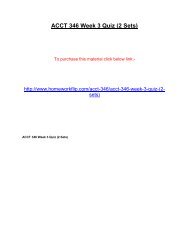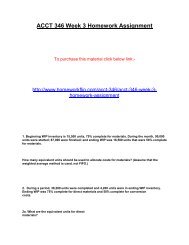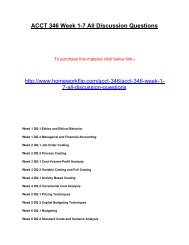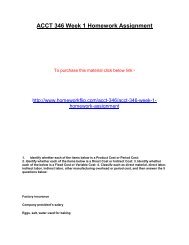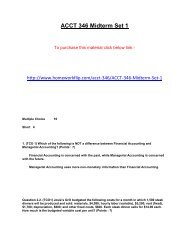ACCT 346 Week 8 Final Exam
Create successful ePaper yourself
Turn your PDF publications into a flip-book with our unique Google optimized e-Paper software.
<strong>ACCT</strong> <strong>346</strong> <strong>Week</strong> 8 <strong>Final</strong> <strong>Exam</strong><br />
To purchase this material click below link:-<br />
http://www.homeworkflip.com/acct-<strong>346</strong>/acct-<strong>346</strong>-week-8-<br />
final-exam<br />
1.Question :<br />
(TCO 1) The principle managers follow when they only investigate significant departures from the<br />
plan is commonly known as<br />
Points Received:<br />
4 of 4<br />
2.Question :<br />
(TCO 1) Which of the following is not likely to be a fixed cost?<br />
Points Received:<br />
4 of 4<br />
3.Question :<br />
(TCO 2) Which of the following is not a manufacturing cost?<br />
Points Received:<br />
4 of 4<br />
4.Question :
(TCO 2) An allocation base is<br />
Points Received:<br />
4 of 4<br />
5.Question :<br />
(TCO 3) Equivalent units are calculated by<br />
Points Received:<br />
4 of 4<br />
6.Question :<br />
(TCO 3) In the assembly department, all the direct materials are added at the beginning of the<br />
processing. Beginning Work in Process inventory consists of 2,000 units with a direct materials<br />
cost of $31,860. During the period, 15,000 units are started and direct materials costing $250,000<br />
are charged to the department. If there are 1,000 units in ending inventory, what is the cost per<br />
equivalent unit?<br />
Points Received:<br />
4 of 4<br />
7.Question :<br />
(TCO 4) Regression analysis<br />
Points Received:<br />
4 of 4<br />
8.Question :<br />
(TCO 4) The number of units that must be sold to exactly cover its fixed and variable costs is the<br />
Points Received:<br />
4 of 4<br />
9.Question :<br />
(TCO 5) Which of the following is treated as a product cost in variable costing?<br />
Points Received:<br />
4 of 4
10.Question :<br />
(TCO 5) If the number of units sold is less than the number of units produced<br />
Points Received:<br />
4 of 4<br />
11.Question :<br />
(TCO 6) A contract which specifies that the suppler will be paid for the cost of production as well<br />
as some fixed amount or percentage of cost is called a(n)<br />
Points Received:<br />
4 of 4<br />
12.Question :<br />
(TCO 6) Which of the following is not generally true when a company compares ABC and<br />
traditional costing?<br />
Points Received:<br />
4 of 4<br />
13.Question :<br />
(TCO 7) Fixed costs that will be eliminated if a particular course of action is undertaken are called<br />
Points Received:<br />
4 of 4<br />
Page:<br />
1.Question :<br />
(TCO 7) Common costs<br />
Points Received:<br />
4 of 4<br />
2.Question :<br />
(TCO 8) Target costing<br />
Points Received:
4 of 4<br />
3.Question :<br />
(TCO 8) Which of the following are relevant in deciding whether to accept or reject a special<br />
order?<br />
Points Received:<br />
4 of 4<br />
4.Question :<br />
(TCO 9) Present value techniques<br />
Points Received:<br />
4 of 4<br />
5.Question :<br />
(TCO 9) The internal rate of return<br />
Points Received:<br />
4 of 4<br />
6.Question :<br />
(TCO 10) A method of budget preparation that requires all budgeted amounts to be justified by the<br />
department, even if the amounts were supported in prior periods, is called<br />
Points Received:<br />
4 of 4<br />
7.Question :<br />
(TCO 10) Which budget is prepared first?<br />
Points Received:<br />
4 of 4<br />
8.Question :<br />
(TCO 10) The standard cost is<br />
Points Received:
4 of 4<br />
9.Question :(TCO 10) In general, an unfavorable material variance arises from<br />
Points Received:<br />
4 of 4<br />
10.Question :(TCO 10) The type of center that has responsibility for generating revenue as well as<br />
controlling costs is a(n)<br />
Points Received:<br />
4 of 4<br />
11.Question :(TCO 10) Responsibility accounting holds managers responsible for<br />
Points Received:<br />
4 of 4<br />
12.Question :(TCO 10) Which ratio measures the rate earned on total capital provided by the<br />
owners?<br />
Points Received:<br />
4 of 4<br />
Page:<br />
1.Question :(TCO 1) Distinguish managerial accounting from financial accounting. Include a brief<br />
discussion of the differences in the types of information provided to users as well as the<br />
differences of the users of the accounting information.<br />
Points Received:<br />
20 of 20<br />
2.Question :(TCO 6) Booth Financial Services, LLC has two revenue producing departments,<br />
Financial Planning and Business Consulting. The accounting department is trying to determine<br />
the best method to allocate $1,000,000 of common costs (secretarial staff, reception personnel,<br />
etc), either by salary or number of employees. Information on the revenue departments are as<br />
follows:<br />
Department<br />
Employees<br />
Salaries
Financial Planning<br />
150 employees<br />
$10,000,000<br />
Business Consulting<br />
50 employees<br />
$5,000,000<br />
(a) Allocate the $1,000,000 common costs to the two revenue departments using both methods.<br />
(b) Why are allocations called arbitrary?<br />
Points Received:<br />
25 of 25<br />
3.Question :<br />
(TCO 10) Charlie Corp sells it products on both credit and cash basis. Monthly sales are sold 20%<br />
for cash, 80% for credit. Credit sales are collected 40% in the month of sale and 60% the following<br />
month. Sales for the first quarter are as follows:<br />
January $100,000<br />
February $150,000<br />
March $125,000<br />
Compute cash collections for February.<br />
Points Received:<br />
25 of 25<br />
4.Question :<br />
(TCO 2) Acme Fireworks uses a traditional overhead allocation based on direct labor hours. For<br />
the current year overhead is estimated at $1,000,000 and direct labor hours are budgeted at<br />
200,000 hours. Actual hours worked were 195,000 and actual overhead was $978,000.<br />
(a) Compute the predetermined manufacturing overhead rate.<br />
(b) Compute the applied manufacturing overhead.<br />
(c) Compute the amount of over/under applied manufacturing overhead.<br />
Points Received:<br />
25 of 25<br />
Page:
1 2 3 4<br />
1.Question :<br />
(TCO 9) An investment of $185,575 is expected to generate returns of $65,000 per year for each of<br />
the next four years. What is the investment's internal rate of return?<br />
Points Received:<br />
25 of 25<br />
2.Question :<br />
(TCO 4) Legal Docs Inc is a legal services firm that files incorporation papers for small<br />
businesses. They charge $1,000 per application. This year's income statement shows the<br />
following:<br />
Sales $1,295,000<br />
Variable Expenses $1,023,000<br />
Contribution margin $272,000<br />
Fixed costs $250,000<br />
Profit $22,000<br />
Required:<br />
(a) Compute the break-even point in units.<br />
(b) Compute the contribution margin ratio.<br />
(c) Compute the current margin of safety.<br />
(d) How many applications must the company sell to make a profit of $350,000?<br />
Points Received:<br />
25 of 25<br />
3.Question :(TCO 5) The following data has been taken from Air-Tite company in its first year of<br />
business.<br />
Units produced 100,000<br />
Units sold 80,000<br />
Units in ending inventory 20,000<br />
Fixed manufacturing overhead $400,000<br />
(a) Compute the amount of fixed manufacturing overhead that would be expensed in the current<br />
year if full absorption costing is used.<br />
(b) Compute the amount of fixed manufacturing overhead that would be expensed in the current<br />
year if variable costing is used.<br />
(c) Compute the amount of fixed manufacturing overhead that would be included in ending<br />
inventory under full absorption costing.<br />
Points Received:<br />
25 of 25


